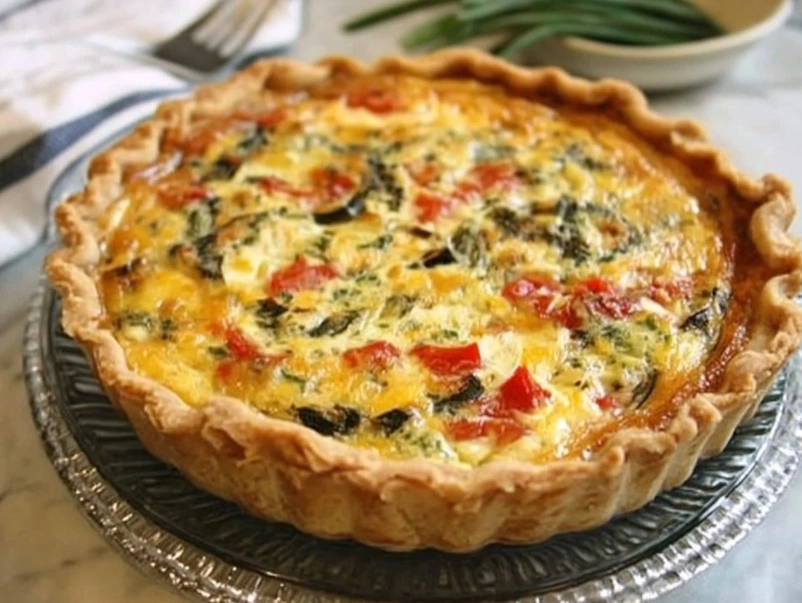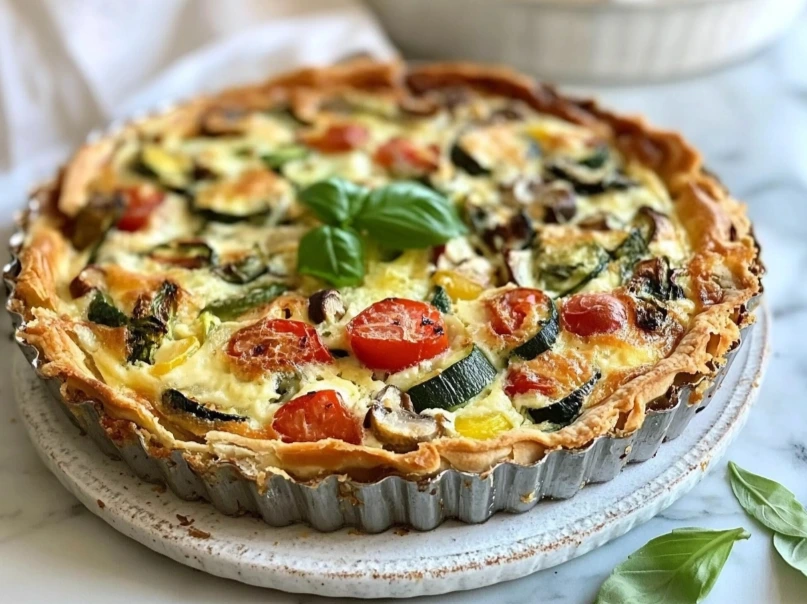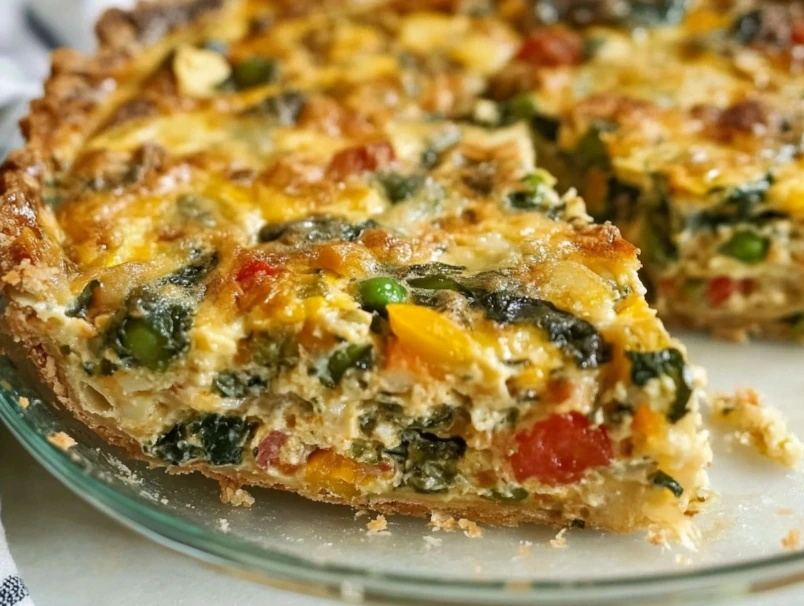A veggie quiche recipe is a must-have for anyone seeking a delicious and versatile dish. Combining fresh vegetables, creamy custard, and a flaky crust, this recipe is perfect for breakfast, brunch, or even dinner. Whether you’re a seasoned chef or a beginner in the kitchen, this guide will help you create the ultimate veggie quiche that everyone will love.
Benefits of Adding Veggie Quiche to Your Diet
A veggie quiche recipe isn’t just a delicious addition to your recipe repertoire; it also brings a host of benefits to your lifestyle and health. Here’s why you should consider making it a regular feature on your menu:
Nutritional Advantages
A veggie quiche recipe is a nutrient powerhouse. Packed with a variety of vegetables, it’s a great way to increase your daily intake of vitamins, minerals, and fiber. Vegetables like spinach, bell peppers, zucchini, and mushrooms are common quiche ingredients, each offering unique health benefits:
- Spinach: High in iron, magnesium, and vitamin K, spinach supports bone health and energy production.
- Bell Peppers: Loaded with vitamin C and antioxidants, these add a burst of flavor and health to your quiche.
- Zucchini: Low in calories but high in hydration and fiber, zucchini is excellent for digestion and weight management.
- Mushrooms: A good source of B vitamins and selenium, mushrooms enhance your immune function and metabolic processes.
Pairing these with protein-rich eggs and calcium-packed cheese makes veggie quiche a balanced, nutrient-dense meal.
Ideal for Meal Prep
Veggie quiche recipe is a dream dish for meal preppers. Here’s why:
- Easy to Make in Advance: Quiches can be prepared ahead of time and stored in the refrigerator or freezer, making them perfect for busy weeks.
- Customizable Ingredients: Use whatever vegetables are in season or available in your kitchen to create a unique flavor profile every time.
- Versatile Serving Options: Enjoy it warm, cold, or at room temperature. It can be a hearty breakfast, a light lunch, or a satisfying dinner.
- Portion Control: A quiche can be sliced into individual portions, making it easy to grab and go.
Ingredients Required for Veggie Quiche Recipe
Crafting a delicious veggie quiche recipe starts with gathering the right ingredients. From a buttery crust to the freshest vegetables, each component plays a vital role in the final dish. Let’s break down the essentials.
Essential Components for the Base
The base of your veggie quiche consists of three primary elements: the crust, the custard, and the cheese. Here’s what you’ll need:
- The Crust:
- Premade Pie Crust: A store-bought crust works well if you’re short on time.
- Homemade Pie Crust: For a truly homemade touch, prepare a simple crust using flour, butter, and a pinch of salt. Whole-grain or gluten-free flours can be used for dietary preferences.
- The Custard:
- Eggs (4–6): Eggs are the foundation of the quiche, providing structure and richness.
- Milk or Cream (1–1.5 cups): For a creamy texture, use heavy cream, half-and-half, or milk. Non-dairy alternatives like almond milk or oat milk work well for a dairy-free version.
- The Cheese:
- Shredded Cheese (1–2 cups): Choose a cheese that melts beautifully, such as cheddar, Gruyère, Swiss, or mozzarella. For a tangy twist, consider feta or goat cheese.
Suggested Vegetables and Substitutions
The beauty of a veggie quiche lies in its adaptability. You can use a variety of vegetables based on your preferences or what’s in season. Here are some popular choices and potential substitutions:
- Spinach:
- Fresh or frozen spinach adds vibrant color and a nutrient boost. Swap with kale or Swiss chard for a heartier green.
- Bell Peppers:
- Red, yellow, or green bell peppers provide sweetness and crunch. Substitute with diced tomatoes or roasted red peppers for a softer texture.
- Mushrooms:
- Cremini, button, or shiitake mushrooms bring an earthy flavor. For a different texture, try zucchini or eggplant.
- Onions:
- Sautéed yellow, red, or green onions enhance the quiche’s depth of flavor. Shallots or leeks are great alternatives.
- Broccoli or Cauliflower:
- Small florets of these vegetables add a hearty bite. Substitutions include asparagus tips or Brussels sprouts.
- Carrots:
- Grated carrots add a hint of sweetness and vibrant color. Sweet potatoes or parsnips can provide a similar flavor profile.
Herbs and Seasonings
- Fresh or dried herbs like parsley, thyme, basil, or dill enhance the flavor. Don’t forget salt, pepper, and a pinch of nutmeg for a classic quiche seasoning.

Step-by-Step Guide to Preparing the Crust
A perfect quiche starts with a great crust. Whether you prefer a classic pastry crust or a gluten-free, low-carb alternative, the following steps will guide you through the process.
Making a Classic Pastry Crust
- Ingredients:
- 1 ¼ cups all-purpose flour
- ½ teaspoon salt
- ½ cup unsalted butter (cold and cubed)
- 2–4 tablespoons ice water
- Instructions:
- Mix Dry Ingredients: In a large bowl, combine flour and salt.
- Cut in Butter: Add cold butter cubes to the flour mixture. Use a pastry cutter or your fingers to work the butter into the flour until it resembles coarse crumbs.
- Add Ice Water: Gradually add ice water, 1 tablespoon at a time, mixing until the dough comes together. Avoid overmixing.
- Chill the Dough: Shape the dough into a disc, wrap it in plastic wrap, and refrigerate for at least 30 minutes.
- Roll Out the Dough: On a lightly floured surface, roll out the dough into a circle slightly larger than your pie dish. Carefully transfer it to the dish and trim the edges.
- Blind Bake (Optional): For a crisper crust, pre-bake it. Cover the crust with parchment paper, fill with pie weights or dried beans, and bake at 375°F (190°C) for 10–12 minutes. Remove weights and paper, and bake for another 5 minutes.
Opting for a Gluten-Free or Low-Carb Crust
For dietary preferences, try these alternatives:
- Gluten-Free Crust:
- Use a store-bought gluten-free flour mix or combine almond flour and coconut flour for a homemade version.
- Follow the same steps as the classic crust, adjusting the water slightly based on the flour’s absorbency.
- Low-Carb Crust:
- Mix 1 ½ cups almond flour, ¼ cup coconut flour, and 1 egg. Add 2 tablespoons melted butter or coconut oil.
- Press the mixture directly into the pie dish (no rolling required), then bake at 350°F (175°C) for 10 minutes before adding the filling.
Preparing the Filling for Veggie Quiche
The filling is where you can get creative. Choose a balance of creamy custard, flavorful cheese, and fresh vegetables to make your quiche shine.
Choosing the Right Cheese
The choice of cheese significantly impacts the flavor and texture of your quiche. Here are some popular options:
- Cheddar: A classic choice with sharp, tangy notes.
- Gruyère or Swiss: Adds a nutty, rich flavor.
- Mozzarella: Perfect for a milder taste and gooey texture.
- Feta or Goat Cheese: Ideal for a tangy, creamy touch.
- Parmesan: Use sparingly to enhance flavor without overpowering.
Best Spices and Herbs for Flavor
Seasonings elevate the quiche from good to extraordinary. Consider these options:
- Spices:
- Salt and Black Pepper: The basics that enhance all other flavors.
- Nutmeg: A traditional quiche spice that adds warmth and depth.
- Paprika or Cayenne Pepper: For a hint of spice and color.
- Herbs:
- Fresh Herbs: Parsley, thyme, dill, basil, or chives add freshness.
- Dried Herbs: Oregano, rosemary, or herbes de Provence offer a robust flavor.
- Optional Add-Ins:
- A touch of garlic powder or onion powder for savory depth.
Assembling and Baking the Veggie Quiche
With your crust and filling prepared, it’s time to assemble your veggie quiche and bake it to perfection. Follow these steps for a flawless result.
Layering the Ingredients
- Prepare the Crust:
- Ensure your crust (classic, gluten-free, or low-carb) is pre-baked or ready for filling.
- Layer the Cheese:
- Spread a layer of shredded or crumbled cheese across the bottom of the crust. This creates a barrier to help prevent the crust from becoming soggy.
- Add the Vegetables:
- Evenly distribute your prepared vegetables (sautéed or raw, depending on their texture) over the cheese layer. Be mindful not to overfill, leaving room for the custard to envelop the vegetables.
- Pour the Custard:
- Slowly pour the egg and milk mixture over the vegetables and cheese, ensuring an even spread. Use the back of a spoon to gently adjust the filling if needed.
- Optional Toppings:
- Sprinkle additional cheese or a pinch of fresh herbs on top for added flavor and presentation.
Baking Tips for a Perfectly Set Quiche
- Bake at the Right Temperature:
- Preheat your oven to 375°F (190°C). This temperature ensures the custard sets without overcooking.
- Monitor Cooking Time:
- Bake for 35–45 minutes, or until the custard is set and the top is golden brown. A knife inserted into the center should come out clean.
- Prevent Over-Browning:
- If the crust or top begins to brown too quickly, cover it loosely with aluminum foil during the final 10–15 minutes of baking.
- Allow Cooling:
- Let the quiche cool for at least 10 minutes before slicing. This helps the filling firm up and makes for cleaner cuts.

Serving and Storing Your Veggie Quiche
Once baked, your veggie quiche is ready to enjoy. Here’s how to serve it creatively and store leftovers for later.
Pairing Suggestions
- Light Side Dishes:
- Serve your quiche with a fresh green salad drizzled with vinaigrette for a balanced meal.
- Pair with a bowl of soup, like tomato bisque or a light vegetable broth.
- Brunch Favorites:
- Add roasted potatoes, fresh fruit, or a simple fruit salad to create a satisfying brunch spread.
- Beverages:
- Coffee or tea complements a quiche during breakfast or brunch.
- For dinner, pair it with a crisp white wine, like Sauvignon Blanc or Chardonnay.
Proper Storage and Reheating Techniques
- Refrigerating Leftovers:
- Cover the quiche tightly with plastic wrap or transfer slices to an airtight container. Store in the refrigerator for up to 4 days.
- Freezing for Later:
- Wrap the entire quiche or individual slices in plastic wrap and then foil. Freeze for up to 2 months.
- Thaw in the refrigerator overnight before reheating.
- Reheating Tips:
- Oven: Warm the quiche in a 350°F (175°C) oven for 15–20 minutes to retain its texture and flavor.
- Microwave: Reheat individual slices on medium power for 1–2 minutes, though this may slightly soften the crust.
Frequently Asked Questions About Veggie Quiche Recipe
Can I Freeze a Veggie Quiche?
Yes, veggie quiche can be frozen for later enjoyment. To freeze:
- Allow the quiche to cool completely after baking.
- Wrap it tightly in plastic wrap and then in aluminum foil to prevent freezer burn.
- Freeze for up to 2 months. To reheat, thaw the quiche in the refrigerator overnight and warm it in a 350°F (175°C) oven for 15–20 minutes.
What Are the Best Cheeses for Veggie Quiche?
The choice of cheese depends on your flavor preferences. Popular options include:
- Cheddar: Adds a sharp, tangy flavor.
- Gruyère or Swiss: Provides a nutty and rich taste.
- Mozzarella: Offers a mild and gooey texture.
- Feta or Goat Cheese: Adds a tangy, creamy element.
- Parmesan: A little goes a long way for enhancing the overall flavor.
How Do I Prevent a Soggy Bottom Crust?
To avoid a soggy bottom crust:
- Blind Bake the Crust: Pre-bake the crust before adding the filling. Line it with parchment paper, fill it with pie weights, and bake for 10–12 minutes at 375°F (190°C).
- Layer Cheese First: Add a layer of cheese to the crust before pouring in the custard to create a barrier against moisture.
- Drain Vegetables Well: Sauté or pat dry watery vegetables, like zucchini or mushrooms, to remove excess moisture.
Can I Make Veggie Quiche Without Eggs?
Yes, you can make an egg-free veggie quiche using substitutes:
- Silken Tofu: Blend it with a bit of plant-based milk and seasonings to mimic the texture of eggs.
- Chickpea Flour Batter: Combine chickpea flour, water, and seasonings to create a custard-like filling.
- Vegan Egg Replacers: Commercial products designed for baking can work well as substitutes.
Is Veggie Quiche Suitable for a Vegan Diet?
Yes, veggie quiche can be made vegan with a few substitutions:
- Crust: Use a vegan pie crust made without butter or animal products.
- Custard: Replace eggs with silken tofu, chickpea flour, or a vegan egg substitute.
- Cheese: Use plant-based cheeses or nutritional yeast for a cheesy flavor.
How Long Does Veggie Quiche Last in the Fridge?
Veggie quiche can be stored in the refrigerator for up to 4 days. Ensure it is tightly covered with plastic wrap or stored in an airtight container to maintain freshness. For longer storage, consider freezing individual slices.
To make your veggie quiche even more versatile, consider pairing it with other recipes from Starry Recipes. For a gluten-free option, explore this Gluten-Free Croissant recipe, which can also double as a crust alternative for your quiche. If you’re looking for another variation, the Vegetable Quiche Recipe offers a delightful twist with unique flavor combinations. For a quick and easy approach, you might explore this Bisquick Quiche Recipe for a time-saving option without compromising on taste.
Conclusion
Veggie quiche is a versatile, nutritious, and flavorful dish that can suit any occasion, from a cozy brunch to a meal prep staple. With a flaky crust, creamy custard, and vibrant vegetables, it’s a perfect balance of taste and health. By exploring various crust options, experimenting with different cheeses, and seasoning it with your favorite herbs, you can create a quiche that’s uniquely your own.
Whether you’re making it for a quick weekday meal or a special gathering, the veggie quiche will always deliver satisfaction. Don’t forget to pair it with complementary dishes and utilize proper storage techniques to enjoy it fresh every time. Happy cooking!

